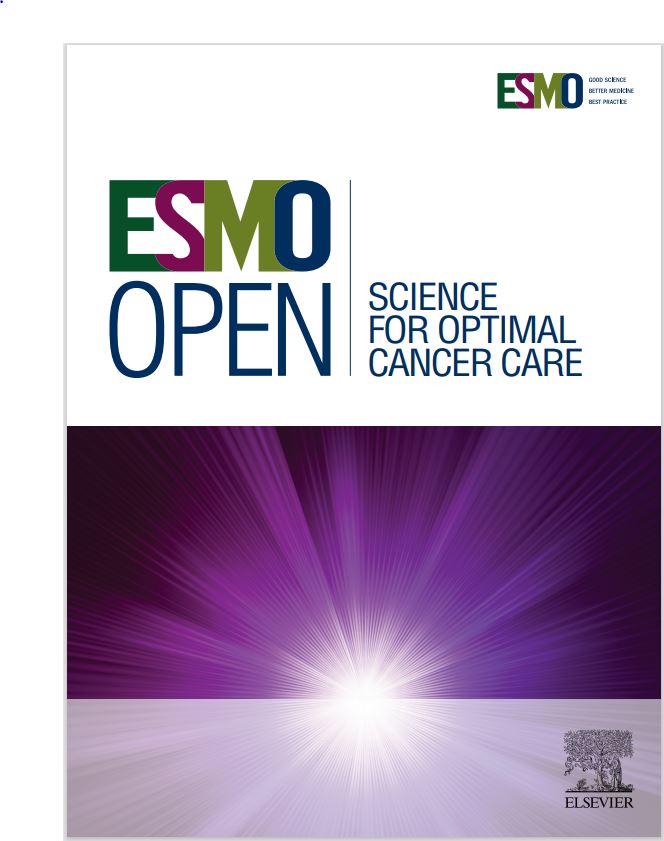J-ALEX研究中阿勒替尼耐药相关基因改变的血浆cfDNA分析
IF 8.3
2区 医学
Q1 ONCOLOGY
引用次数: 0
摘要
作为间变性淋巴瘤激酶(ALK)重排非小细胞肺癌(NSCLC)的标准一线治疗药物,对alectinib的耐药仍然是一个主要的临床挑战。本研究旨在利用无浆细胞DNA (cfDNA)的下一代测序(NGS)研究耐药机制。材料和方法在J-ALEX研究的67例alectinib组患者的基线、第57天和停止治疗时收集血浆样本。提取cfDNA并使用NGS检测ALK继发性突变(SMs)和其他与耐药相关的遗传改变。比较有和没有检测到SMs的患者的无进展生存期(PFS)。结果67例患者中有9例(13%)检测到耐药ALK,包括耐药突变,如L1196M和G1202R。检测到SMs的患者PFS明显缩短[15.2个月;95%置信区间(CI) 10.2-25.2个月]与未检测到SMs的患者相比[34.1个月;95% CI 20.3 ~ 55.0个月;风险比2.28,95% CI 1.01 ~ 5.16, P = 0.005]。鉴定了其他可操作的突变,包括MET扩增和KRAS G12D/NRAS G13S。KRAS和NRAS突变,在两名PFS较短(2.9和4.4个月)的患者中观察到,提示与原发性耐药的潜在联系。结论应用NGS分析血浆cfDNA是可行的,并为阿勒替尼耐药机制的研究提供了新的思路。早期发现耐药性相关突变可以指导个性化的治疗策略。需要更大规模的前瞻性研究来验证这些发现。本文章由计算机程序翻译,如有差异,请以英文原文为准。
Plasma cfDNA analysis of alectinib resistance-related gene alterations in the J-ALEX study
Background
Resistance to alectinib, the standard first-line therapy for anaplastic lymphoma kinase (ALK)-rearranged non-small-cell lung cancer (NSCLC), remains a major clinical challenge. This study aimed to investigate resistance mechanisms using next-generation sequencing (NGS) of plasma cell-free DNA (cfDNA).
Materials and methods
Plasma samples from 67 patients in the alectinib group of the J-ALEX study were collected at baseline, on day 57, and at treatment discontinuation. cfDNA was extracted and analyzed using NGS to detect ALK secondary mutations (SMs) and other resistance-related genetic alterations. Progression-free survival (PFS) was compared between patients with and without detectable SMs.
Results
Alectinib-resistant ALK SMs were detected in 9 of the 67 patients (13%), including resistance mutations, such as L1196M and G1202R. Patients with detected SMs had a significantly shorter PFS [15.2 months; 95% confidence interval (CI) 10.2-25.2 months] compared with those without detectable SMs [34.1 months; 95% CI 20.3-55.0 months; hazard ratio 2.28, 95% CI 1.01-5.16, P = 0.005]. Additional actionable mutations were identified, including MET amplification and KRAS G12D/NRAS G13S. KRAS and NRAS mutations, observed in two patients with a shorter PFS (2.9 and 4.4 months), suggested a potential link to primary resistance.
Conclusions
Plasma cfDNA analysis using NGS is feasible and offers insights into alectinib resistance mechanisms. Early detection of resistance-associated mutations may guide personalized treatment strategies. Larger prospective studies are needed to validate these findings.
求助全文
通过发布文献求助,成功后即可免费获取论文全文。
去求助
来源期刊

ESMO Open
Medicine-Oncology
CiteScore
11.70
自引率
2.70%
发文量
255
审稿时长
10 weeks
期刊介绍:
ESMO Open is the online-only, open access journal of the European Society for Medical Oncology (ESMO). It is a peer-reviewed publication dedicated to sharing high-quality medical research and educational materials from various fields of oncology. The journal specifically focuses on showcasing innovative clinical and translational cancer research.
ESMO Open aims to publish a wide range of research articles covering all aspects of oncology, including experimental studies, translational research, diagnostic advancements, and therapeutic approaches. The content of the journal includes original research articles, insightful reviews, thought-provoking editorials, and correspondence. Moreover, the journal warmly welcomes the submission of phase I trials and meta-analyses. It also showcases reviews from significant ESMO conferences and meetings, as well as publishes important position statements on behalf of ESMO.
Overall, ESMO Open offers a platform for scientists, clinicians, and researchers in the field of oncology to share their valuable insights and contribute to advancing the understanding and treatment of cancer. The journal serves as a source of up-to-date information and fosters collaboration within the oncology community.
 求助内容:
求助内容: 应助结果提醒方式:
应助结果提醒方式:


